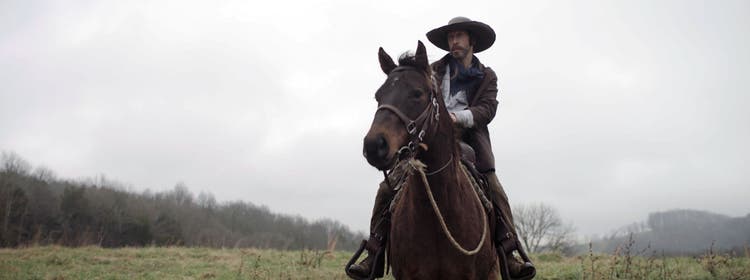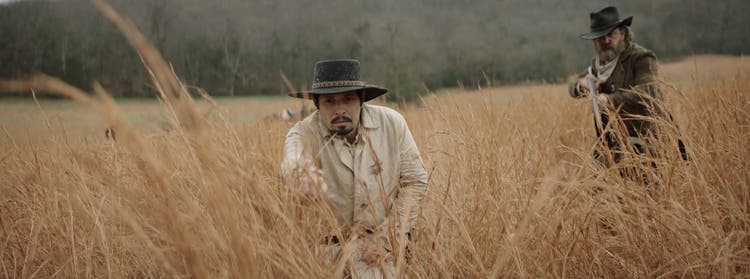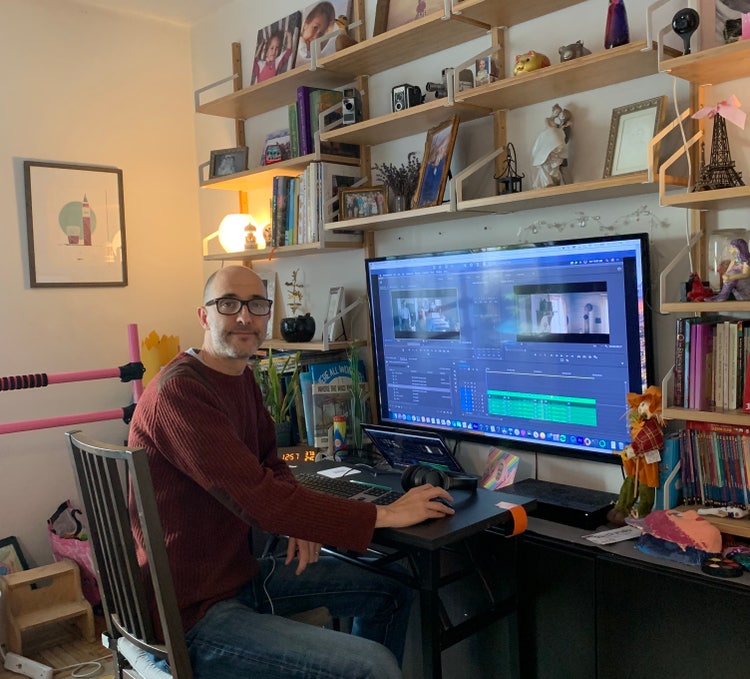Out West with Old Henry editor Jamie Kirkpatrick

Image source: Shout! Studios.
Old Henry follows a widowed farmer (Tim Blake Nelson) and his son who warily take in an injured man (Scott Haze) with a satchel of cash. When a posse claiming to be the law shows up, the farmer must decide whom to trust. Having debuted earlier this year at the Venice International Film Festival, the film is now playing in theatres.
To celebrate the film’s release, we sat down with the film’s editor, Jamie Kirkpatrick, to learn how he used Premiere Pro to take this film to the wild, wild west.
How and where did you first learn to edit?
I guess I learned to edit in film school at Boston University, but the fire to do it for a living was sparked during a summer internship in Hollywood. Through six degrees of separation, I met legendary film editors Billy Weber and Donn Cambern who offered me an internship on a film they were cutting. Steven Spielberg was one of the producers and one day he came into the cutting room to help fix a troublesome section of the film. I was invited to sit in and observe and when I saw what they were able to achieve — exclusively through editing technique and craft — I knew that’s what I wanted to do with my life.
How do you begin a project/set up your workspace?
I begin every project before shooting starts by doing a lot of research into great films that are in the same genre or share a similar tone or sensibility to the film I’m about to edit. It’s also important to me that the editing room be a space in which the director feels protected and comfortable, but also inspired. I have a framed photograph of Fellini with a bull whip taken behind-the-scenes on the set of 8 ½ (he was teaching Marcello Mastroianni how to crack it). I put that up somewhere in every cutting room as a little bit of inspiration (for the director, but also myself) and to remind me that it’s okay to experiment and take bold swings creatively.
Tell us about a favorite scene or moment from this project and why it stands out to you.
(Mild Spoiler Alert!)
The big shootout when the posse arrives at Henry’s door was really fun but also challenging to put together. I’ve cut action scenes that involved gun-play before but never anything of this scale with lots of actors, half a dozen trained horses, practical special effects and stunts. The whole sequence in the film only lasts about a minute but there was a ton of footage to piece it together. Normally on a Western, a scene like this might take a week to shoot but ours was shot in one day. The fact that I actually had everything I needed, and it came out so well (in my humble opinion) is a testament to the vision of our director, Potsy Poncirolli, and the talent of our cinematographer John Matysiak.

Image source: Shout! Studios.
What were some specific post-production challenges you faced that were unique to your project? How did you go about solving them?
The COVID-19 pandemic meant that, while the film was shot outside of Nashville, I had to work from my apartment in Manhattan. Our budget didn’t allow for a robust remote workstation, so I was actually using my laptop to remotely connect to an edit station at a post facility in Nashville, where the project and media actually lived. I’m used to having a director in the room with me, to bounce ideas off of and talk through how best to solve something. In this case Potsy and I were swapping a lot of texts, calls and Zooms. Believe it or not, he and I have never even met in person. His vision for the film, which we talked through before the shoot, was crystal clear and he told me that after he saw my first cut, he trusted that we were on the same page and he let me do my thing. That kind of trust from a director is rare and I’m really grateful to him for it.
What Adobe tools did you use on this project and why did you originally choose them? Why were they the best choice for this project?
I was told from my hiring that because Potsy was more familiar with Premiere Pro, and because I’d be remote, that we would be cutting on that. While I had used Premiere Pro on many projects, including several network television shows, I had never cut a feature on it. I had always enjoyed the sense of fluidity I felt working in Premiere Pro so I was excited to apply that to a movie. I had also been hearing through the grapevine that Fincher’s editorial team (who were also working remotely) were all having a great experience with Premiere’s new Productions framework. I did some deep research and convinced the producers and the assistant editor Donny Bitinger (who was based in Nashville) to use Productions. It turned out to be a great decision as Donny would often be working and updating our ‘DAILIES’ project, while I was working on a ‘SCENE CUTS’ project. Once I had enough scenes to start stringing together sequences, I’d create a ‘SEQUENCES’ project, and so on. This organizational structure meant that none of our projects ever got too large and could be opened really quickly.
What do you like about Premiere Pro, and/or any of the other tools you used?
One of my favorite aspects of Premiere Pro is the filters and effects. As someone who is pretty unfamiliar with After Effects, I find it incredibly intuitive and elegant — just the ease with which you can modify any clip in your timeline.
Another thing I love about Premiere Pro is what I’ve already referred to as the “fluidity.” My friend and fellow editor Sarah Flack once predicted that future editing software will likely resemble the technology that Tom Cruise uses in Minority Report — we will wear gloves and VR-type glasses and grab, move and trim virtual clips on a virtual timeline using our hands. Premiere Pro is the closest thing to that feeling, kind of effortlessly moving things wherever you want them.
What’s your hidden gem/favorite workflow tip in Adobe Creative Cloud?
I don’t know if it qualifies as a hack, but I love the Color Correction tools. I was given daily look-up-tables (LUTs) by our cinematographer, but sometimes they needed to be tweaked and it was just so effortless to pop into the Color workspace and instantly adjust the contrast, for instance.
Who is your creative inspiration and why?
I was fortunate enough to have worked under and alongside some exceptional editors and they’ve all inspired me in some way. But in terms of someone whose career has had an active influence on my own it would have to be Thelma Schoonmaker, who has cut virtually all of Martin Scorsese’s films. I don’t think there’s another living editor who has a filmography as diverse as hers. The film industry tends to pigeonhole people, especially editors, but she has proven that great artists make great art, and it doesn’t matter the size and shape of the canvas. She has edited sports dramas (Raging Bull), effects-heavy epics (Hugo), documentaries (Woodstock), crime dramas (Goodfellas), costume dramas (The Age of Innocence), bio-pics (The Aviator), comedies (The King of Comedy), pulp thrillers (Cape Fear) and gothic horror (Shutter Island). I find her career incredibly inspiring and have made a concerted effort to work on films that vary in genre and style, and I have no doubt that this has made me a better editor.
What’s the toughest thing you’ve had to face in your career and how did you overcome it? What advice do you have for aspiring filmmakers or content creators?
Wow, that’s a great question and not one I’m often asked. If I’m being honest the toughest thing I’ve faced in my career is getting fired. It’s more accurate to say “replaced”, because it’s pretty rare that you’re sitting on the opposite side of a desk from someone telling you, “You’re fired.” It’s usually more like a phone call from an associate producer saying, “The director has decided to go in another direction.” Oftentimes that’s the only explanation provided. Fortunately, this has only happened to me once but, at the time, it was pretty devastating. When it happened, I remembered an old mentor of mine, Julian Semilian, saying that you’re not a real editor until you’ve been fired. I’ve come to realize how right he was because after that experience — when my life didn’t end, and I just moved on to the next project — being replaced wasn’t some existential fear for me anymore. So, apropos of that, my advice to creative people in general is to just make the best work you can. If it’s good, people will notice. Worrying about the other stuff is just a waste of energy.
Share a photo of where you work. What’s your favorite thing about your workspace and why?
To be clear, this is far from my favorite workspace. This is me editing Old Henry, from my laptop and using our TV as a monitor while my two kids (not pictured) are sitting behind me on Zoom school last year. I would use headphones, but sometimes I’d get into a particularly violent scene and then hear one of my daughters telling her teacher, “Sorry, I got distracted. My dad’s editing some guy killing another guy with an ax.”

Image source: Shout! Studios.
Old Henry is now available on Blu Ray and streaming on demand.